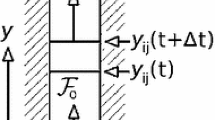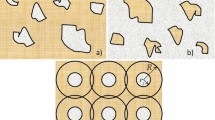Abstract
One-dimensional non-Darcy flow in a semi-infinite porous media is investigated. We indicate that the non-Darcy relation which is usually determined from experimental results can always be described by a piecewise linear function, and the problem can be equivalently transformed to a multiphase implicit Stefan problem. The novel feature of this Stefan problem is that the phases of the porous media are divided by hydraulic gradients, not the excess pore water pressures. Using the similarity transformation technique, an exact solution for the situation that the external load increases in proportion to the square root of time is developed. The study on the existence and uniqueness of the solution leads to the requirement of a group of inequalities. A similar Stefan problem considering constant surface seepage velocity is also investigated, and the solution, which we indicate to be uniquely existent under all conditions, is established. Meanwhile, the relation between our Stefan problem and the traditional multiphase Stefan problem is demonstrated. In the end, computational examples of the solution are presented and discussed. The solution provides a useful benchmark for verifying the accuracy of general approximate algorithms of Stefan problems, and it is also attractive in the context of inverse problem analysis.





Similar content being viewed by others
References
Rubinstein, L.: The Stefan Problem, vol. 27. American Mathematical Society, Providence (1971)
Alexiades, V., Solomon, A.D.: Mathematical Modeling of Melting and Freezing Processes. Hemisphere, Washington (1983)
Crank, J.: Free and Moving Boundary Problems. Clarendon Press, Oxford (1984)
Lunardini, V.J.: Heat Transfer with Freezing and Thawing. Elsevier, Amsterdam (1991)
Gupta, S.C.: The Classical Stefan Problem, Basic Concepts, Modelling and Analysis. Elsevier, Amsterdam (2003)
Voller, V.R.: A similarity solution for solidification of an under-cooled binary alloy. Int. J. Heat Mass Transf. 49, 1981–1985 (2006)
Storti, M.: Numerical modeling of ablation phenomena as two-phase Stefan problems. Int. J. Heat Mass Transf. 38, 2843–2854 (1995)
Chung, H., Das, S.: Numerical modeling of scanning laser-induced melting, vaporization and resolidification in metals subjected to step heat flux input. Int. J. Heat Mass Transf. 47, 4153–4164 (2004)
Rajeev, K., Rai, N., Das, S.: Numerical solution of a moving-boundary problem with variable latent heat. Int. J. Heat Mass Transf. 52, 1913–1917 (2009)
Lorenzo-Trueba, J., Voller, V.R.: Analytical and numerical solution of a generalized Stefan problem exhibiting two moving boundaries with application to ocean delta formation. J. Math. Anal. Appl. 366, 538–549 (2010)
Marcus, E.A.S., Tarzia, D.A.: Explicit solution for freezing of humid porous half-space with a heat flux condition. Int. J. Eng. Sci. 38, 1651–1665 (2000)
Lombardi, A.L., Tarzia, D.A.: Similarity solutions for thawing processes with a heat flux condition at the fixed boundary. Meccanica 36, 251–264 (2001)
Nicolin, D.J., Jorge, R.M.M., Jorge, L.M.M.: Stefan problem approach applied to the diffusion process in grain hydration. Transp. Porous Media 102, 387–402 (2014)
Nicolin, D.J., Jorge, R.M.M., Jorge, L.M.M.: Moving boundary modeling of conventional and transgenic soybean hydration: moisture profile and moving front experimental validation. Int. J. Heat Mass Transf. 90, 568–577 (2015)
Pascal, F., Pascal, H., Murray, D.W.: Consolidation with threshold gradients. Int. J. Numer. Anal. Methods Geomech. 5, 247–261 (1981)
Chen, Y.M., Tang, X.W., Wang, J.: An analytical solution of one-dimensional consolidation for soft sensitive soil ground. Int. J. Numer. Anal. Methods 28, 919–930 (2004)
Tao, L.N.: The exact solutions of some Stefan problems with prescribed heat flux. J. Appl. Mech. 48, 732–736 (1981)
Rogers, C.: Application of a reciprocal transformation to a two-phase Stefan problem. J. Phys. A Math. Gen. 18, L105–L109 (1985)
Cherniha, R.M., Cherniha, N.D.: Exact solutions of a class of nonlinear boundary value problems with moving boundaries. J. Phys. A Math. Gen. 26, L935–L940 (1993)
Broadbridge, P., Pincombe, B.M.: The Stefan solidification problem with nonmonotonic nonlinear heat diffusivity. Math. Comput. Model. 23, 87–98 (1996)
Briozzo, A.C., Tarzia, D.A.: An explicit solution for an instantaneous two-phase Stefan problem with nonlinear thermal coefficients. IMA J. Appl. Math. 67, 249–261 (2002)
Voller, V.R., Swenson, J.B., Paola, C.: An analytical solution for a Stefan problem with variable latent heat. Int. J. Heat Mass Transf. 47, 5387–5390 (2004)
Cherniha, R., Kovalenko, S.: Exact solutions of nonlinear boundary value problems of the Stefan type. J. Phys. A Math. Theor. 42, 355202 (2009)
Cherniha, R., Kovalenko, S.: Lie symmetries of nonlinear boundary value problems. Commun. Nonlinear Sci. Numer. Simul. 17, 71–84 (2012)
Zhou, Y., Wang, Y.J., Bu, W.K.: Exact solution for a Stefan problem with latent heat a power function of position. Int. J. Heat Mass Transf. 69, 451–454 (2014)
Zhou, Y., Xia, L.J.: Exact solution for Stefan problem with general power-type latent heat using Kummer function. Int. J. Heat Mass Transf. 84, 114–118 (2015)
Zhou, Y., Zhou, G.Q., Bu, W.K.: Approximate analytical solution for nonlinear multiphase Stefan problem. J. Thermophys. Heat Transf. 29, 417–422 (2015)
Xie, K.H., Wang, K., Wang, Y.L., et al.: Analytical solution for one-dimensional consolidation of clayey soils with a threshold gradient. Comput. Geotech. 37, 487–493 (2010)
Zhou, Y., Bu, W.K., Lu, M.M.: One-dimensional consolidation with a threshold gradient: a Stefan problem with rate-dependent latent heat. Int. J. Numer. Anal. Methods Geomech. 37, 2825–2832 (2013)
Liu, W.C., Yao, J., Wang, Y.Y.: Exact analytical solutions of moving boundary problems of one-dimensional flow in semi-infinite long porous media with threshold pressure gradient. Int. J. Heat Mass Transf. 55, 6017–6022 (2012)
Liu, W.C., Yao, J., Chen, Z.X.: Analytical solution of a double moving boundary problem for nonlinear flows in one-dimensional semi-infinite long porous media with low permeability. Acta. Mech. Sin. 30, 50–58 (2014)
Mitchell, J.K., Younger, J.S.: Abnormalities in Hydraulic Flow Through Fine-Grained Soils. ASTM Special Publication, American Society for Testing and Materials, Philadelphia (1967)
Hansbo, S.: Consolidation of clay with special reference to influence of vertical sand drains. Swed. Geotech. Inst. Proc. 18, 45–50 (1960)
Tang, X.W., Onitsuka, K.: Consolidation by vertical drains under time-dependent loading. Int. J. Numer. Anal. Methods Geomech. 24, 739–751 (2000)
Qin, A.F., Sun, D.A., Tan, Y.W.: Analytical solution to one-dimensional consolidation in unsaturated soils under loading varying exponentially with time. Comput. Geotech. 37, 233–238 (2010)
Olver, F.W.J., Lozier, D.W., Boisvert, R.F., et al.: NIST Handbook of Mathematical Functions. Cambridge University Press, New York (2010)
Wilson, D.G.: Existence and uniqueness for similarity solutions of one dimensional multi-phase Stefan problems. SIAM J. Appl. Math. 35, 135–147 (1978)
Tao, L.N.: The heat conduction problem with temperature dependent material properties. Int. J. Heat Mass Transf. 32, 487–491 (1989)
Funding
The project was supported by the Fundamental Research Funds for the Central Universities (Grant 2015XKMS014). Special thanks to the anonymous reviewers for their comments which have greatly improved this article.
Author information
Authors and Affiliations
Corresponding author
Appendices
Appendix A: Proof of the statements for \(p= i+1\)
Firstly, the auxiliary function \(g_{i}(x)\) is defined using Eq. (50) with \(p=i\)+1, and the following recurrence formula can be deduced from the definition of \(f_{i}(x)\)
The function \(f_{i+1}(x)\) is then defined as
Also the right hand side of Eq. (A2) should be less than 1, thus we have
The domain of definition \(I_{i+1}\) is the non-negative solution of Eq. (A3). With x increasing from 0 to \(y_{i-1}\), the left hand side of Eq. (A3) decreases from erfc(\({\beta }_{i}E_{i})\hbox {exp}({\beta }_{i}^{2}E_{i}^{2})\) to 0, while the right hand side is an increasing function of x and always be positive (from the recurrence formula Eq. (A1)). Thus, there will be unique positive \(y_{i}\) in \(I_{i}\) which makes two sides of Eq. (A3) equal if Eq. (A4) is satisfied, and then the domain of definition \(I_{i+1}\) is [0, \(y_{i})\)
Using the recurrence formula Eq. (A1) repeatedly, Eq. (A4) can be transformed to the inequality presented in Eq. (48) with \(p=i\)+1.
The function \(f_{i+1}(x)\) can then be rewritten as
The auxiliary function \(U_{i+1}(x)\) is still defined in the form of Eq. (49) with \(p=i+1\), and it is obvious that \(U_{i+1}(x)\) is positive. The derivative of \(f_{i+1}(x)\) can be determined from its definition
Multiplying both sides of Eq. (A3) with \(\sqrt{{\uppi }}\beta _i f_i\), we can deduce \(\sqrt{{\uppi }}\beta _i f_i g_i <1\); thus \(f_{i+1}(x)\) is an increasing function of x, and it increases from \(E_{i+1}\) to \(+\infty \) with x increasing from 0 to \(y_{i}\), where \(E_{i+1}\) is given by Eq. (47) with \(p=i+1\). From lemmas 3-4 in Ref. [37], \(U_{i+1}(x)\) can also be proved as an increasing function of x. Thus all the statements for \(p=i+1\) have been verified.
Appendix B: Discussion of the inequalities
Considering that the inequalities in Eq. (48) for \(p \leqslant n+1\) are satisfied, then all the functions \(f_{i}(x)\) and the values \(E_{i}=f_{i}(0)\) are well defined. This Appendix investigates the monotonicity properties of the functions on two sides of Eq. (48).
The coefficients of consolidation \(c_{\mathrm{v}i}\), the critical hydraulic gradients \(J_{i}\) are all given constants, thus both sides of Eq. (48) are seemed as functions of a single augment \(q_{\mathrm{c}}\), and we use \(K_{1}\) as the augment instead for convenience.
The functions on the left hand side of Eq. (48) are increasing functions of \(K_{1}\), while for the functions on the right hand side, the monotonicity is studied by an induction process.
The functions on the right hand side of Eq. (48) for \(p = 2, 3\) are \(R_{1}(K_{1})\) = 1 and
Equation (B1) indicates that \(R_{2}(K_{1})\) is a decreasing function of \(E_{2}\). Since \(E_{2 }= \hbox {inverf}(K_{1})\) is an increasing function of \(K_{1}\), we know that \(R_{2}(K_{1})\) is a decreasing function of \(K_{1}\), and it can also be deduced from \(E_{1} = 0\) that \(E_{2}^{2}-{\beta }_{1}^{2}E_{1}^{2}\) is an increasing function of \(K_{1}\).
Assuming for \(s = 2,3,{\ldots },i\), we have already proved that \(R_{s}(K_{1})\) is a decreasing function of \(K_{1}\), and \(E_{s}, E_{s}^{2}-{\beta }_{s-1}^{2}E_{s-1}^{2}\) are increasing functions of \(K_{1}\).
For \(s=i+1\), there is
Equation (B2) can be transformed to
The right hand side of Eq. (B3) is a decreasing function of \(K_{1}\), thus we have
in which \({E}'_i \) represents \(\hbox {d}E_{i}/\hbox {d}K_{1}\).
Equation (B4) indicates that \({E}'_{i+1} > 0\). Using lemma 3 in Ref. [37], we can deduce
The right hand side of Eq. (48) for \(p=i+2 (s=i+1)\) can be written as
From Eq. (B5), \(E_{i+1}^{2}-{\beta }_{i}^{2}E_{i}^{2}\) is an increasing function of \(K_{1}\). For the function on the rightmost hand side of Eq. (B6), the denominator is an increasing function of \(K_{1}\), while the numerator is a decreasing function of \(K_{1}\), therefore \(R_{i+1}(K_{1})\) is a decreasing function of \(K_{1}\). All the statements for \(s=i+1\) have been verified. Through the induction process, we know that the functions on the right hand side of Eq. (48) are all decreasing functions of \(K_{1}\).
Since \(K_{1}\) is a decreasing function of \(q_{\mathrm{c}}\), above discussions indicate that in order to satisfy the inequalities presented in Eq. (48), \(q_{\mathrm{c}}\) should be large enough.
Rights and permissions
About this article
Cite this article
Zhou, G.Q., Zhou, Y. & Shi, X.Y. One-dimensional non-Darcy flow in a semi-infinite porous media: a multiphase implicit Stefan problem with phases divided by hydraulic gradients. Acta Mech. Sin. 33, 855–867 (2017). https://doi.org/10.1007/s10409-017-0649-8
Received:
Revised:
Accepted:
Published:
Issue Date:
DOI: https://doi.org/10.1007/s10409-017-0649-8




